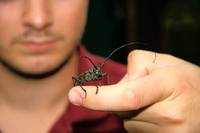Giant extinct beetle discovered on a pavement
 An amazing giant insect, classified as being extinct in the UK, was discovered on a pavement outside an industrial unit in Ashchurch, Gloucestershire last week. The Capricorn Beetle was found by a member of the public (John Hawkins) who handed it over to the Tewkesbury Council Environmental Health Department. The Beetle has since been re-homed at the Stratford Butterfly Farm. Experts there are still baffled as to how an extinct British Beetle came to be found on a pavement in the neighbouring county. It is thought that the Beetle was probably brought into the country in imported oak timber.
An amazing giant insect, classified as being extinct in the UK, was discovered on a pavement outside an industrial unit in Ashchurch, Gloucestershire last week. The Capricorn Beetle was found by a member of the public (John Hawkins) who handed it over to the Tewkesbury Council Environmental Health Department. The Beetle has since been re-homed at the Stratford Butterfly Farm. Experts there are still baffled as to how an extinct British Beetle came to be found on a pavement in the neighbouring county. It is thought that the Beetle was probably brought into the country in imported oak timber. Capricorn Beetles were believed to have disappeared in the UK in the early 18th century; however they are still found in France and other parts of the Continent, but are classified as extremely rare. The Beetle is one of Europe’s largest kinds of Beetle and comes from the Cerambycidae (long horn) family of Beetles.
Long horn Beetles are easily recognized by their very long antennae (often twice the length of the Beetle’s body) which are used by males to detect the pheromone scent emitted by females. This particular beetle, thought to be male, measures 3.5cm long with its antennae reaching just over 6cm. The beetles make an eerie screeching noise by rubbing their legs together to warn off predators. They have large, powerful jaws capable of biting through wood and can give a nasty nip.
The adult beetles feed only on fruit and tree sap. The larvae or grubs serve an important role in the forest because they feed on rotten oak wood thus helping to recycle nutrients back into the ecosystem. The beetles are now increasingly rare because dead trees and rotting timber are generally ‘tidied up’ from woods and forests leaving no food source for the beetles’ larvae. In timber the grubs can wreak tremendous havoc as they munch through the wood, leaving large hollow chambers. They spend over two years as a larva, tunnelling through the wood before pupating and finally emerging as an adult for a brief life in which to mate and lay eggs.
The Capricorn Beetle will remain at Stratford Butterfly Farm where visitors can marvel at his size and many other strange and fascinating insects. For more information please visit the official website at Butterflyfarm.co.uk.

